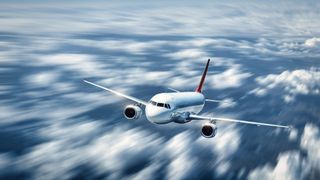
Can a commercial airplane do a barrel roll?
Pilots have been doing barrel rolls in small planes throughout the history of aviation. But has anyone ever attempted this maneuver in a commercial airliner?

Anyone who has ever attended an air show has witnessed the death-defying acrobatics performed by pilots. But one maneuver stands out as a crowd favorite: the barrel roll, in which an airplane does a complete 360-degree rotation while airborne.
It should come as no surprise that accomplishing this exercise is no easy feat — even in a small stunt plane or fighter jet — and it takes a skilled pilot to execute it. But is it possible to do a barrel roll in something larger, like a commercial airliner?
Richard P. Anderson — a pilot, professor of aerospace engineering and director of the Eagle Flight Research Center at Embry-Riddle Aeronautical University in Florida — said it is, and even knows people who have proof of doing them.
"I know people on their own with videotapes [doing barrel rolls]," Anderson told Live Science.
Perhaps the most famous pilot ever to accomplish one in a commercial plane was Alvin Melvin "Tex" Johnston, a test pilot for Boeing. In the summer of 1955, Johnston took a four-engine Boeing 367-80 (also known as the Dash 80) out for a spin — literally.
Related: What happens when a plane makes an emergency landing?
To impress Boeing executives watching from a yacht on Lake Washington near Seattle, the "maverick pilot" did two barrel rolls, along with a chandelle, a stunt in which a pilot combines a 180-degree turn with a climb, according to the Los Angeles Times. That Monday, Johnston's boss called him into his office and asked him what he was doing. Johnston reportedly replied, "Selling airplanes," according to Plane & Pilot Magazine.
Sign up for the Live Science daily newsletter now
Get the world’s most fascinating discoveries delivered straight to your inbox.
So how did he successfully execute a barrel roll in such a large aircraft? Anderson said the size of the plane doesn't matter as much as the pilot's ability to temper the amount of g-forces placed on the aircraft during the roll.
"The physics are the same regardless of the size of the airplane," Anderson said. "In a barrel roll, the pilot is trying to keep the g-loading on the airplane near 1 g. In other words, pretty close to what we feel here on Earth."
To complete the maneuver, the pilot must do the roll while also pitching the plane's nose up and then letting the nose fall downward — all while flying the aircraft at cruising speed, which is roughly 550 to 600 mph (885 to 965 km/h), as if it’s soaring through a barrel, according to Flying magazine.
"The only real limiting thing about doing a barrel roll is how fast the airplane rolls," Anderson said. "In a barrel roll, what you do is pull the nose up, and as you do the roll, you let the nose fall, which allows you to keep this low-stress environment. As the nose falls as you roll, what you have to do is be able to get the airplane all the way around in its roll prior to the nose pointing too far down. As long as the airplane has a reasonable roll rate, the physics say that any size airplane can do it."
David Haglund, a veteran pilot for the U.S. Air Force and a docent at The Museum of Flight near Seattle, added that the amount of airspace available to complete the roll is also important, especially in a large airplane versus a small Cessna.
"Before performing this maneuver, a pilot would consider the airspace available," Haglund told Live Science in an email. "In an airliner, a barrel roll would require a block of altitude 2,000 feet [600 meters] above and below the level flight altitude (4,000 feet total) [12,000 m] to be on the safe side."
But although it's physically possible, some manufacturers have built a limitation into large, modern-day aircraft, perhaps to dissuade any future Tex Johnstons from performing similar acrobatic feats, especially with passengers on board.
"The Airbus doesn't give the pilot the ability to roll beyond 60 degrees of bank without disabling part of the auto-flight system that governs the plane's operating envelope," said Haglund, who has experience flying A330 and A350 models.

Jennifer Nalewicki is a Salt Lake City-based journalist whose work has been featured in The New York Times, Smithsonian Magazine, Scientific American, Popular Mechanics and more. She covers several science topics from planet Earth to paleontology and archaeology to health and culture. Prior to freelancing, Jennifer held an Editor role at Time Inc. Jennifer has a bachelor's degree in Journalism from The University of Texas at Austin.